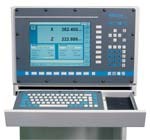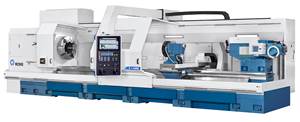Re-Evaluating The Controlled Cycle Lathe
The gap between manual lathes as found in a toolroom and CNC turning centers as found in a production plant is very wide. Many applications call for something in between--a turning machine that not only lends itself to making a single part or a small batch of parts, but also lends itself to complex or difficult operations.
The gap between manual lathes as found in a toolroom and CNC turning centers as found in a production plant is very wide. Many applications call for something in between—a turning machine that not only lends itself to making a single part or a small batch of parts, but also lends itself to complex or difficult operations. Lathe manufacturers have responded to this demand by developing a class of turning machines that is rather diverse and goes by a variety of names. These machines have been called semi-CNC, semi-automatic, teachable, hybrid and controlled cycle lathes. The common characteristic of these machines is that they can be operated in a mode involving some level of electronic assistance. Many also can be operated in a strictly manual mode with the operator simply working the handwheels.
The level of electronic assistance found on these machines varies widely. It ranges from a level one step above a simple digital readout that gives the operator prompts, to a level one step below full CNC in which automatic operation does not require standard G-code program input. Given this broad range of electronic modes, it is not surprising that no single term has emerged as an acceptable name for this category of machines.
One of the machine tool builders that is particularly active in this area is Weiler Machine Tools, a German builder with U.S. offices in Fort Mill, South Carolina. This 64-year old firm has a strong reputation in Europe as a builder of high precision toolroom lathes and CNC turning centers. About 10 years ago, the firm began introducing precision lathes with automatic cycles. Although these machines have been widely accepted in Europe, Weiler has found that these machines are not well understood in the U.S. market.
The company ascribes part of this resistance to the general confusion surrounding this category of machines and the unsatisfactory experience some users have had with lower quality imports. Another factor is the scarcity of skilled lathe operators in this country, causing many U.S. companies to conclude that only full CNC machines are the answer to this situation.
Weiler company officials would say that these companies are overlooking a better solution, the lathe with automatic cycles, which the company is now promoting under the term "controlled cycle" lathes. This name seems to be favored because it succinctly characterizes the high level of electronic assistance that it offers while preserving the flexibility that manual operation provides.
The threading routines that can be called up and executed on a Weiler controlled cycle lathe show how one of these machines can perform operations in a way that neither a manual nor a CNC machine could. Recutting a threaded workpiece provides the best example. Responding to prompts on the control interface, the operator selects a thread type, the start and stop points of the thread, and the diameter. The handwheel is used to locate the bottom of the existing thread, and then the operator presses the key to memorize this position. At this point, the operator has an option to start the cycle and let it run with limited handwheel input or choose to maintain complete control over both axes. The lathe will continue to run along the established lead, or the operator may manipulate the axis input using the two handwheels. The display continues to maintain the location, aiding the operator in decisions concerning changes in axis input. According to Weiler, this mode of operation reduces the time of manual rework by about 75 percent compared to unassisted operation, noting that it would be virtually impossible to perform this operation on a CNC machine.
The control features also allow contour routines to be "memorized" easily. The operator generates the contour profile by entering a series of simple profile elements and related dimensions, then lets the system automatically calculate points of intersection, radius blends, tapers and other math functions.
Shop managers who believe that CNC versus manual operation in turning is an either/or situation should take a closer look at the spectrum of machines that fill the gap. These managers may discover a class of turning equipment, such as the Weiler controlled cycle lathes, that transcends both manual and CNC machines. These lathes perform complicated turning operations impossible to do on any manual lathe and, compared to a full CNC machine, they offer considerable time saving through shorter programming and quicker tool setups.
Related Content
Deep Hole Drilling Without Drift
A deep hole drill with intuitive controls and minimal hole drift was one shop's pipe dream — until the shop helped a machine tool builder make it.
Read MoreInside the Premium Machine Shop Making Fasteners
AMPG can’t help but take risks — its management doesn’t know how to run machines. But these risks have enabled it to become a runaway success in its market.
Read MoreRomi Launches Flatbed Lathe for Machining Large Parts
The C 1100H is a heavy-duty flatbed lathe built with a monoblock cast iron bed that absorbs machining efforts and vibration, making it highly rigid, stable and accurate.
Read MoreThreading On A Lathe
The right choices in tooling and technique can optimize the thread turning process.
Read MoreRead Next
3 Mistakes That Cause CNC Programs to Fail
Despite enhancements to manufacturing technology, there are still issues today that can cause programs to fail. These failures can cause lost time, scrapped parts, damaged machines and even injured operators.
Read MoreThe Cut Scene: The Finer Details of Large-Format Machining
Small details and features can have an outsized impact on large parts, such as Barbco’s collapsible utility drill head.
Read More.jpg;maxWidth=970;quality=90)









.jpg;maxWidth=300;quality=90)



.png;maxWidth=300;quality=90)


.png;maxWidth=300;quality=90)











.jpg;maxWidth=970;quality=90)